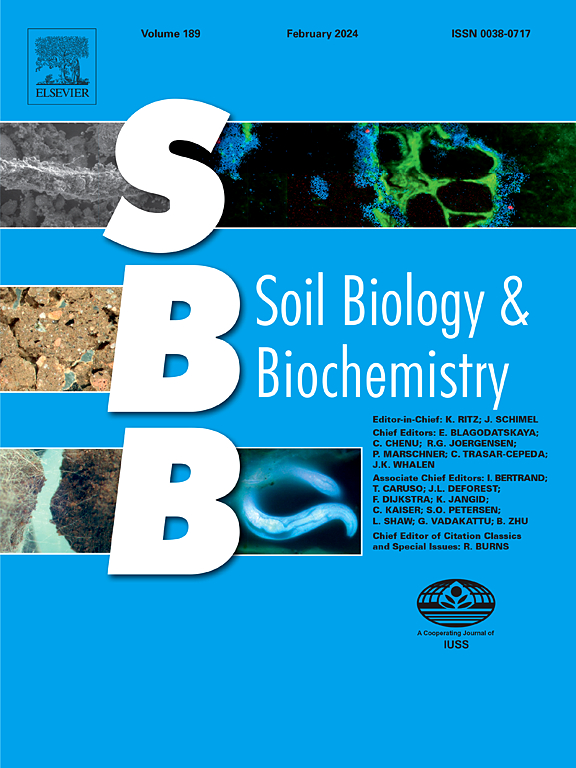两种不同真菌群落耕地土壤中真菌氨基葡萄糖和细菌菌胺的周转与土壤有机碳的比较
IF 10.3
1区 农林科学
Q1 SOIL SCIENCE
引用次数: 0
摘要
微生物坏死物碳(MNC)对土壤有机碳(SOC)的贡献可达50%或以上,因此可能对土壤固碳至关重要。然而,目前尚不清楚MNC的持久性,以及真菌和细菌坏死团C的周转在这方面是否与SOC不同。因此,本研究研究了真菌氨基葡萄糖(GlcN)和细菌乳酸菌酸(MurN)在两种不同真菌群落长期达姆施塔特施肥试验土壤中的周转时间。施用无机肥和秸秆还田(MIN)的土壤腐养真菌含量显著高于施用牛家肥(FYM)的土壤。大流域土壤有机碳(SOC)周转时间为10.0 a,比小流域土壤的8.6 a长16%。土壤微生物生物量C (MBC)周转时间为147 d,是土壤微生物生物量C周转时间(67 d)的2倍以上。真菌GlcN和MurN的周转时间在中下游土壤中约为6.3年,在中下游土壤中约为4.9年。与植物残留物相比,真菌GlcN和MurN在生长过程中不断在微生物生物量中循环,与SOC相比周转时间更短。目前使用的从氨基糖到坏死块的不同转化因子对周转时间的估计只有很小的影响。土壤中微生物C利用效率(CUE)和C输入是影响土壤中MBC和MNC更替的主要因素。对部分分解有机肥(如FYM)的CUE值的认识尤其严重缺乏。未来的研究还需要更准确地估计秸秆、收获残留物、根、根沉积物和有机肥输入的碳的数量和质量。本文章由计算机程序翻译,如有差异,请以英文原文为准。
Turnover of fungal glucosamine and bacterial muramic acid in comparison with soil organic carbon in two arable soils with distinct fungal communities
Microbial necromass carbon (MNC) can contribute 50 % or more to soil organic C (SOC) and may thus be crucial for C sequestration in soil. However, it is not known how persistent MNC is and whether the turnover of fungal and bacterial necromass C differs from that of SOC in this respect. The current study therefore investigates the turnover times of fungal glucosamine (GlcN) and bacterial muramic acid (MurN) in two soils from the long-term Darmstadt fertilization trial with distinct fungal communities. The soil with inorganic fertilization and straw return (MIN) contains significantly more saprotrophic fungi than the organically managed soil with cattle farmyard manure fertilization (FYM). The soil organic carbon (SOC) turnover time was 10.0 years in the FYM soil, 16 % longer than the 8.6 years in the MIN soil. In contrast, the microbial biomass C (MBC) turnover time of 147 days in the FYM soil was more than twice the 67 days found in the MIN soil. The turnover time of fungal GlcN and MurN varied around 6.3 years in the FYM soil and around 4.9 years in the MIN soil. In contrast to plant residues, fungal GlcN and MurN are constantly recycled in the microbial biomass during growth, which results in shorter turnover times compared to SOC. The different conversion factors from amino sugars to necromass currently used have only minor effects on the estimates of turnover times. The main drivers for the turnover of MBC and MNC in soil are microbial C use efficiency (CUE) and C input. There is particularly a serious lack in knowledge on the CUE values of partly decomposed organic fertilizers such as FYM. Future studies also need to more accurately estimate quantity and quality of the C input by straw, harvest residues, roots, rhizodeposits, and organic fertilizers.
求助全文
通过发布文献求助,成功后即可免费获取论文全文。
去求助
来源期刊

Soil Biology & Biochemistry
农林科学-土壤科学
CiteScore
16.90
自引率
9.30%
发文量
312
审稿时长
49 days
期刊介绍:
Soil Biology & Biochemistry publishes original research articles of international significance focusing on biological processes in soil and their applications to soil and environmental quality. Major topics include the ecology and biochemical processes of soil organisms, their effects on the environment, and interactions with plants. The journal also welcomes state-of-the-art reviews and discussions on contemporary research in soil biology and biochemistry.
 求助内容:
求助内容: 应助结果提醒方式:
应助结果提醒方式:


